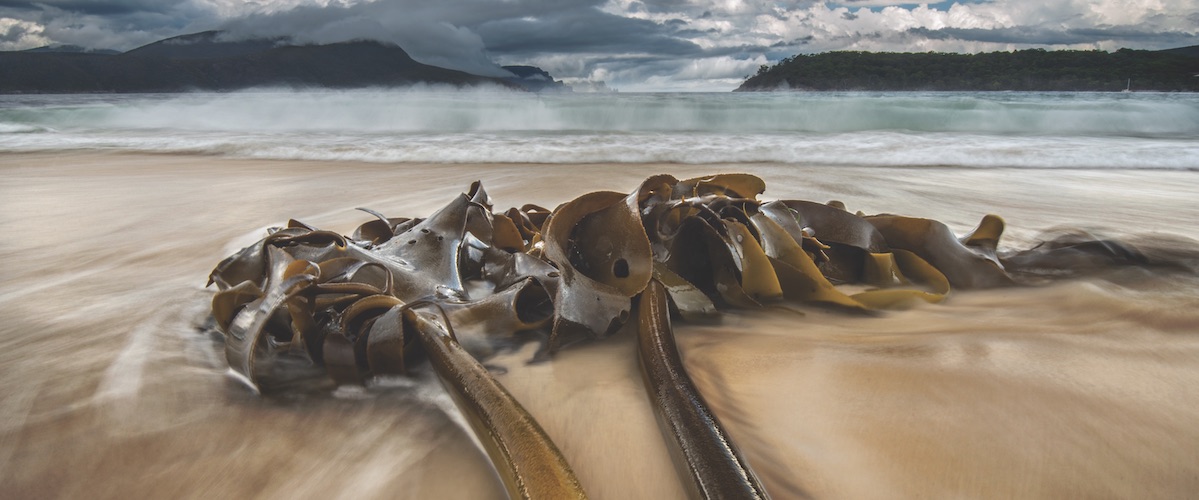
What is Australia’s largest and most commercially valuable reef? It’s not the obvious choice, Queensland’s Great Barrier Reef. Instead, it’s the Great Southern Reef, a name coined in 2016 to bring this vast and under-recognised area to public attention. Justin Gilligan profiles this fragile environment and the threatened kelp species that underpin its ecology.
The sky is bruised following the storm, the air hangs heavy with the smell of salty sea and something slightly putrid, and the kelp, delivered by onshore wind and swell, almost covers the rocky shore. It forms thick, slippery blankets and even hangs from the mouths of cows turned loose to graze on the nutritious castaways.
On King Island, off the northwest coast of Tasmania, bull kelp (Durvillaea potatorum) still thrives, providing the basis for a primary industry. Self-employed kelp harvesters hand-collect the valuable seaweed that washes up on the island’s rocky shore. The ‘kelpies’ clamber over the slippery rocks tying nylon rope to the kelp’s holdfasts, before winching the plants onto trucks and trailers weathered by the salty conditions. These locals make their living or supplement their income by collecting the washed-up seaweed and selling it to the island’s kelp-processing plant to be turned into feed, fertiliser, food and ingredients for cosmetics.
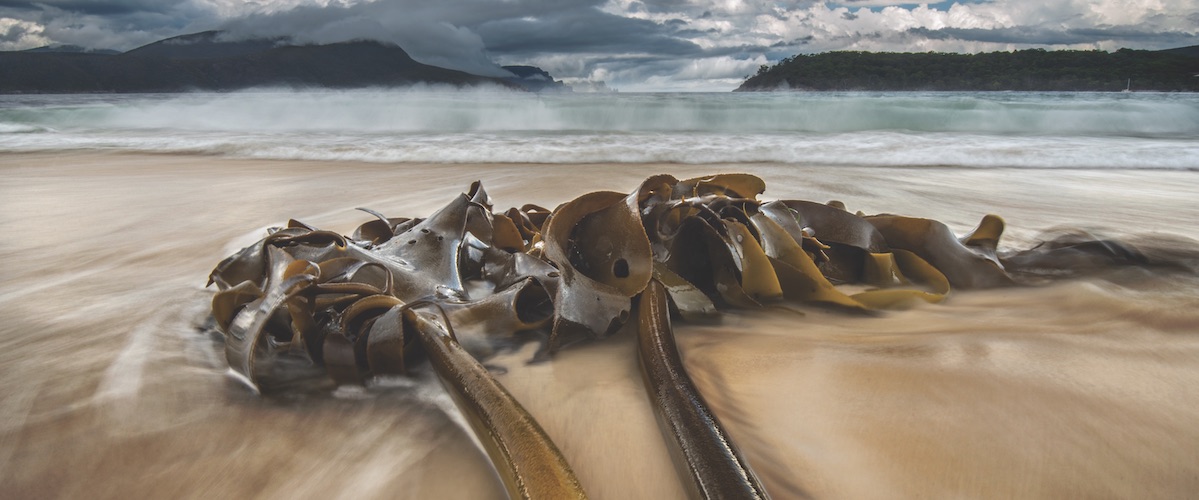
Bull kelp washed up onto the shore of King Island. Image Justin Gilligan
Jason Russell has lived on King Island for most of his life, but only became a kelpie late in 2016. He used to unload southern rock lobsters from commercial fishing vessels, but made the switch when the price of kelp jumped from $300 to $700 a tonne. On a good day he can collect a tonne of kelp, which makes the industry a potentially lucrative option for locals.
In town, the brown algae fills the aisles of the Kelp Craft store, where it’s been fashioned into seahorses, weedy sea dragons and other decorative wall hangings.
Growing to about six metres in length, bull kelp is a robust, low-lying species. It contains the highest level of any Australian seaweed of alginates – used as an additive to a vast range of products, from fruit drinks, ice cream, cosmetics and dyes to pharmaceuticals and bandages. And it can be put to myriad other uses, too, including as a feed in aquaculture, a fertiliser and soil conditioner to replenish depleted soils, and a dietary supplement.
This species is so pervasive on King Island that it’s hard to imagine a future in which it might not exist. But the outlook for the region’s kelp forests is anything but clear.
Just as warm water can cause coral bleaching on the Great Barrier Reef, increasing water temperatures are significantly affecting Australia’s southern reefs. Scientists have identified that Australia’s temperate seas are warming two to four times more rapidly than the global average, largely due to the influence of the East Australian Current off the east coast and the Leeuwin Current off the west coast, both of which transport warm water southward.
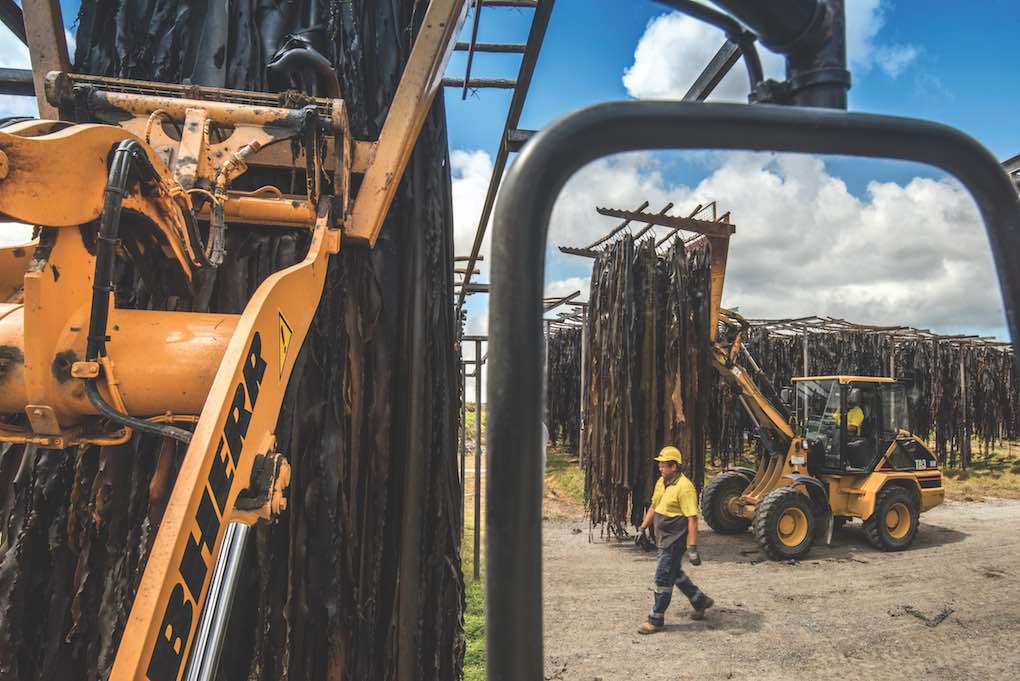
Strands of bull kelp are hung to dry at the local kelp-processing plant. Image Justin Gilligan
Long-term exposure to higher temperatures weakens the seaweed, slows its growth rate and impedes its ability to reproduce. Storms can compromise kelp, as the long algal ropes are frequently ripped loose from the ocean floor. In addition to these direct impacts, ocean warming allows new herbivores, including tropical fish and urchins, to move into kelp forest terrain. In some cases, especially in areas where their natural predators have been fished or hunted too heavily, these invaders can clear-fell large expanses of kelp forest in a matter of months.
In Australian waters, kelp occurs in an area that covers around 71,000 square kilometres and runs for more than 8,000 kilometres along Australia’s southern coastline, from northern New South Wales to Kalbarri in Western Australia and around Tasmania. This area is known as Australia’s Great Southern Reef (GSR). Its northern cousin, the Great Barrier Reef (GBR), is made up of more than 2,900 individual coral-dominated reefs, while the GSR comprises thousands of kelp-dominated rocky reefs. These range from intertidal rock pools to shallow reefs and deep-water environments dominated by sponge gardens.
Kelp is a large, fleshy type of seaweed that can form underwater forests. Like coral, it provides a diversity of habitats for a wide range of other organisms, including crustaceans, chordates, bryozoans, sponges, echinoderms and molluscs. It adds vertical structure while providing shelter, a point of attachment for suspension feeders such as anemones and bryozoans, and a rich source of food for grazers such as marblefish and herring cale.
All this adds up to an extraordinary wealth of biodiversity that includes more than 1,500 seaweed species – substantially more than are found along coastlines of comparable length elsewhere in the world. There are also high levels of endemism. For example, about three-quarters of the 565 red seaweed species the GSR supports are found nowhere else, and among some invertebrate groups, the proportion of endemics is even higher.
The GSR name was coined in a 2016 scientific paper written by a group of prominent scientists from leading marine research institutions who wanted to bring this valuable natural habitat to public attention as a single interconnected system. The authors hope that giving the reef a name will act as the first step towards educating people about the challenges faced by this fragile ecosystem. Those challenges are many and varied, arising from a combination of unprecedented population growth on the adjacent coast and global environmental change. They include pollution, pressure from infrastructure development, introduced species, overfishing and, most destructively, a warming ocean.
It’s the reef’s keystone species group, kelp, that’s really feeling the heat. A recent study examining kelp cover around the world found that in roughly a third of sites it is declining. Unfortunately, that includes much of the GSR. Several mechanisms are behind the loss. In Western Australia, it is marine heatwaves. In northern New South Wales, a ‘tropicalisation’ of the fish community on the reef has seen voracious kelp-grazing rabbitfish move south as the water has warmed. And in South Australia, the kelp has succumbed to years of waste-water pollution. The most dramatic losses, however, have taken place off Tasmania’s east coast.
Tasmania was once home to vast forests of giant kelp (Macrocystis pyrifera), the world’s largest and fastest-growing kelp species. Swimming through a healthy giant kelp forest, in which individual plants can grow 30 metres from the seafloor to the surface, is like flying through a forest of huge swaying beanstalks. Teardrop-shaped gas-bladder floats pull each plant up towards the sun, while at the base, the spindly tendrils of the root-like holdfast secure it to the seafloor.
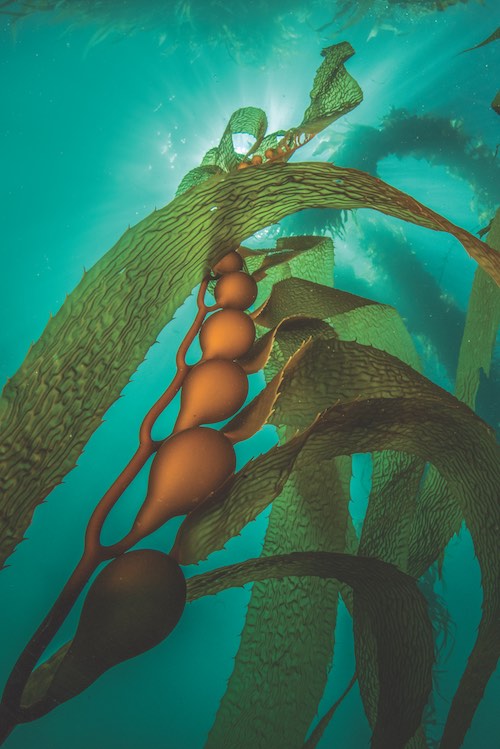
Giant kelp can reach towards the water surface from depths up to 30 metres, drawn upwards by teardrop-shaped gas bladders. Image Justin Gilligan
The arrival of warm, low-nutrient water from the north has weakened the giant kelp forests, making them more susceptible to storms and eventually leading to their collapse across much of their former range. To make matters worse, the warming has also allowed long-spined sea urchins to invade Tasmanian waters. These herbivorous sea creatures can reduce healthy kelp forests to what are known as barrens – areas of bare rock completely devoid of seaweed.
Professor Craig Johnson, Associate Director of the University of Tasmania’s Institute for Marine and Antarctic Studies and one of the authors of the paper, took up a position with the University of Tasmania in 1997, which coincided with the warming of the surrounding water.
He began documenting the impact of warming water on Tasmania’s marine ecosystems. Using a mix of historic and new aerial photography, he showed that between the 1940s and 2011, giant kelp forests have declined by a staggering 95 per cent. Giant kelp forests are now only found in areas that the warm southbound current doesn’t reach off Tasmania’s south coast, around the Actaeon Island Group and in a few sheltered pockets off the state’s west coast.
To better understand kelp as the basic building block of the GSR, Professor Johnson’s research team recently spent three years painstakingly transplanting 500 common kelp plants (Ecklonia radiata) – the most abundant kelp species on the GSR – onto 28 artificial patch reefs, covering more than a hectare near Maria Island.
By controlling the size and density of the kelp cover, the researchers were able to determine the flow-on effects of a thinning of the forests. The results showed that both of these variables had a strong influence on the structure of the communities that formed within the newly established forests, while also highlighting the kelp’s central importance to the health of the reefs.
Professor Johnson hopes the publication of his papers will focus attention on the plight of the GSR, since unfortunately Australia hasn’t been as effective as most of the coral reef community in promoting our temperate reefs. Although the GSR is much larger than its northern cousin and contributes more to the economy, it receives a fraction of the research funding.
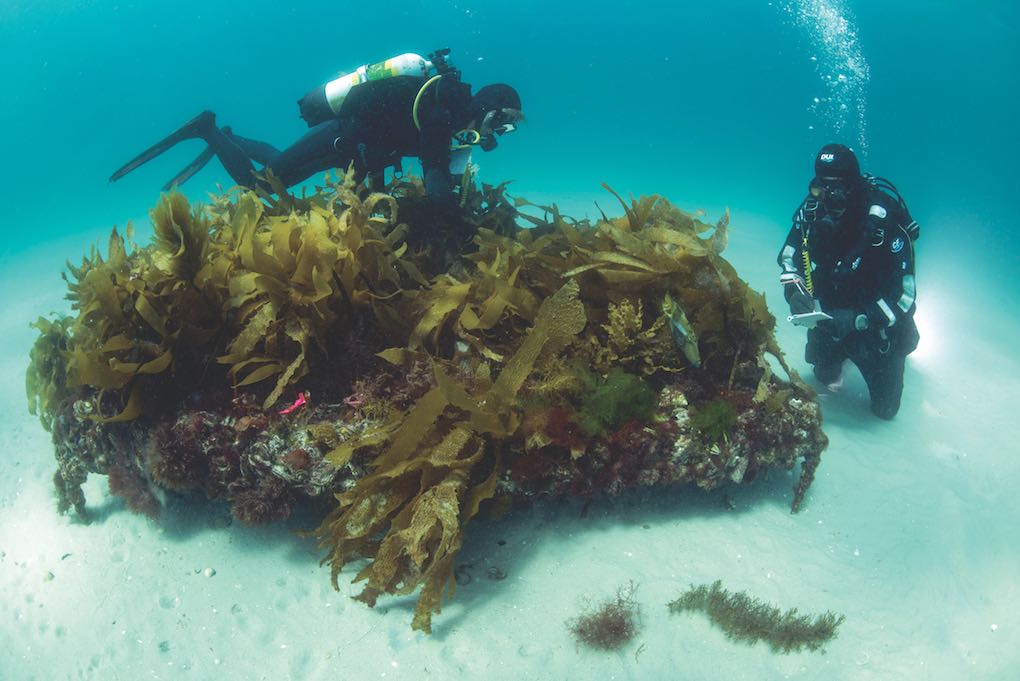
Divers from the University of Tasmania study the flow-on effects of transplanting common kelp onto artificial patch reefs near Maria Island. Image Justin Gilligan
The lack of profile is partly down to the fact that the GSR reefs can be relatively difficult to access. Most are exposed to large swells and, even if you manage to get below the surface, the visibility can be poor. In contrast, it’s easy to get hundreds of divers and snorkelers into the warm waters of the GBR.
That is not to say that the GSR isn’t pulling its economic weight. Conservative estimates suggest fishing and tourism associated with it generate about twice the economic return of the GBR, which is worth about $5.5 billion to the Australian economy. Its most valuable commercial fisheries are rock lobster and abalone, which together contribute about $500 million annually to the nation’s coffers. Tasmania’s wild-caught abalone industry alone is worth $100 million a year. However, the incursion of long-spined sea urchins into Tasmania’s east coast waters is a threat to that industry.
Like the urchins, black-lipped abalone feed on seaweeds, but they are now being overtaken by the spiky intruders. As a result, Tasmania’s east coast abalone production has halved. As with the last remaining stands of giant kelp, Tasmania’s most productive abalone grounds are now located off Actaeon Island and in the state’s south-east.
Only our southernmost waters are stable and out of reach from the warm water, with the reefs continuing to look much healthier than in areas of eastern Tasmania, such as the Tasman Peninsula.
Mick Baron, co-owner of the Eaglehawk Dive Centre, first came to Eaglehawk Neck in the 1970s, when it was a small town in a constriction of the Tasman Peninsula. He made regular weekend visits with a friend from university, where he was studying marine science. Over the years, Mick has watched with growing alarm the changes taking place in the surrounding seas.
When Mick set up the dive centre in 1991 there were giant kelp forests at every site he visited around the Tasman Peninsula. Today the picture is significantly bleaker, with no giant kelp forests occurring in the region.
The GSR is critical to our nation, and we need to look after it, and to acknowledge it in the same way as we do our coral reefs. There are two critical aspects to the future management of the GSR: preventing the loss of the kelp, and restoring parts of it before it is lost forever.
About the author: Justin Gilligan is a freelance photojournalist with an honours degree in marine science. He has worked on numerous projects with Australia’s Commonwealth and State Fisheries Agencies. Several of Justin’s images have received international acclaim in prestigious photography competitions. He was a finalist in Wildlife Photographer of the Year 55.
This article originally appeared in Signals 135, the museum's quarterly magazine.
